The Keele University Chapel and Organ
The UK’s first purpose-built ecumenical place of worship.
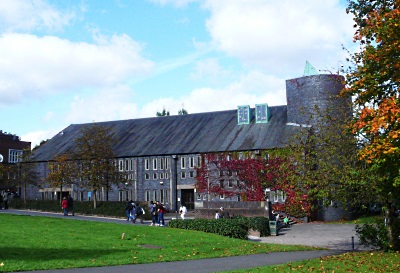 Regardless of whether Keele students have a religious affiliation or none, the Chapel has always been a place to go. Apart from its religious and pastoral functions, the Chapel is a fine public space used for concerts, Graduation Ceremonies, examinations as well as many other get-togethers and special occasions. Students can get a free cup of tea or coffee - with biscuits - or make their way from a late night in the Union to free Tea and Toast provided by the Chapel community. The Chaplaincy team provides a valuable extension to the support services offered by the university and the Students' Union.
Regardless of whether Keele students have a religious affiliation or none, the Chapel has always been a place to go. Apart from its religious and pastoral functions, the Chapel is a fine public space used for concerts, Graduation Ceremonies, examinations as well as many other get-togethers and special occasions. Students can get a free cup of tea or coffee - with biscuits - or make their way from a late night in the Union to free Tea and Toast provided by the Chapel community. The Chaplaincy team provides a valuable extension to the support services offered by the university and the Students' Union.
The Chapel was designed by George Pace CVO, MA, FSA, FR, Hist.S, FRIBA (1915–75). Constructed: 1959–1965 Consecrated 1965.
Photo left: Chapel in 2009 - one of many beautiful photos by Lu Yichao (2009)
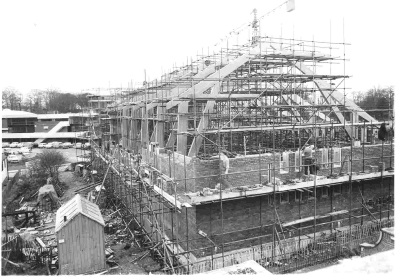 Keele University Chapel is the UK’s first religious building designed specifically to accommodate services by different Christian traditions. Although there were many precedents in terms of shared space and facilities, Keele Chapel is believed to be the first building designed specifically with ecumenical considerations at the forefront.
Keele University Chapel is the UK’s first religious building designed specifically to accommodate services by different Christian traditions. Although there were many precedents in terms of shared space and facilities, Keele Chapel is believed to be the first building designed specifically with ecumenical considerations at the forefront.
Photo right: Building the Chapel, 1965
In 1958, the architect George Pace was appointed to design the University’s first permanent chapel. Students at what was then the University College of North Staffordshire previously worshipped in Keele Hall and then in a large Nissen hut remaining from its wartime role as a military base. A strong religious community has always been a significant feature of Keele University. In 1959 representatives from 10 European countries and the USA met at The Ecumenical Institute of the World Council of Churches to consider the architectural implications of closer cooperation between the denominations and churches. They hammered out a 13-point statement which Pace then used when preparing his plans for a multi-denominational chapel at Keele.
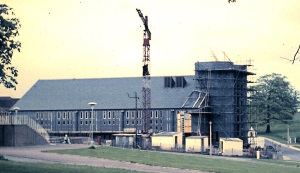 Pace saw that ecumenical relations could affect the way that places of worship were laid out internally. More than anything he saw the need for buildings capable of keeping options open. He set out to design a building where ‘organic development could take place without the great cost of structural alterations or causing violent disruption to a carefully wrought interior.’ He saw that a shared church should be ‘a simple disciplined envelope, non-directional and without built-up drama … capable of infinite rearrangement and re-ordering … Architecture in capital letters should be non-existent. Good building is what is needed.’
Pace saw that ecumenical relations could affect the way that places of worship were laid out internally. More than anything he saw the need for buildings capable of keeping options open. He set out to design a building where ‘organic development could take place without the great cost of structural alterations or causing violent disruption to a carefully wrought interior.’ He saw that a shared church should be ‘a simple disciplined envelope, non-directional and without built-up drama … capable of infinite rearrangement and re-ordering … Architecture in capital letters should be non-existent. Good building is what is needed.’
Photo left: Completing the Towers, 1965 by Graham Fisher (Class of 1965)
The Chapel 2010 by John NeewbyInitial designs for three separate chapels linked by porches and exhibition spaces to form one building were quickly modified. Instead, each congregation – Anglican, Free Church and Roman Catholic – were to be given use of separate sections at appropriate times. The final plan allowed for a large Chapel seating 400 with a central altar table. By lowering a screen wall behind the altar the Chapel could be divided into a main chapel and a smaller one seating 60. The smaller chapel would then be available for use by any of the Churches and denominations.
Photo left: Coming home to Keele after 48 years; John Newby (1962) took this in 2010 during a Pioneers' Reunion
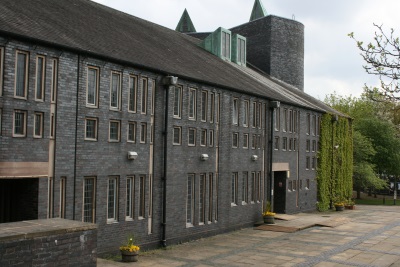 There are two apsidal spaces at the east end of the smaller chapel. One is used by the Roman Catholics for the Reservation of the Blessed Sacrament and the whole of the small chapel space is used during Mass. The other apse was originally used for Anglican and Free Church worship. It is now known as ‘The Space’, a place for quiet reflection for people of all faiths or none. Anglican and Free Church worship take place in the smaller chapel in an area adjacent to that used by the Catholics. In this way, neither the main chapel nor the small chapel is reserved exclusively for one Church or denomination. Yet arrangements can be made, through the lowering of hydraulic screens, to create spaces to suit the requirements of each religious group.
There are two apsidal spaces at the east end of the smaller chapel. One is used by the Roman Catholics for the Reservation of the Blessed Sacrament and the whole of the small chapel space is used during Mass. The other apse was originally used for Anglican and Free Church worship. It is now known as ‘The Space’, a place for quiet reflection for people of all faiths or none. Anglican and Free Church worship take place in the smaller chapel in an area adjacent to that used by the Catholics. In this way, neither the main chapel nor the small chapel is reserved exclusively for one Church or denomination. Yet arrangements can be made, through the lowering of hydraulic screens, to create spaces to suit the requirements of each religious group.
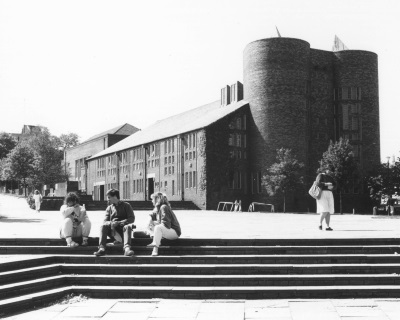 The exterior of the Chapel was designed to be ‘austere, highly disciplined and timeless.’ Originally intended to be faced with sandstone, the generous gift of industrial-style bricks of the University’s choice from the Berry Hill Brick Company resulted in the Chapel’s construction in a striking blue Staffordshire brick. In architectural terms, Keele Chapel represents a transition stage from the ‘natural’ appearance of Scargill Chapel in the Yorkshire Dales and the ‘industrial’ style adopted at Wythenshawe and other housing estate and city churches in the later 1960s.
The exterior of the Chapel was designed to be ‘austere, highly disciplined and timeless.’ Originally intended to be faced with sandstone, the generous gift of industrial-style bricks of the University’s choice from the Berry Hill Brick Company resulted in the Chapel’s construction in a striking blue Staffordshire brick. In architectural terms, Keele Chapel represents a transition stage from the ‘natural’ appearance of Scargill Chapel in the Yorkshire Dales and the ‘industrial’ style adopted at Wythenshawe and other housing estate and city churches in the later 1960s.
Photo right: Chapel and Concourse, 1987
The interior is plain and simple yet meant to convey a sense of the numinous, an effect enhanced by the unusual ‘stepped’ window arrangements. Unfortunately, Niklaus Pevsner, the architectural critic and historian described these merely as ‘windows in the odd rhythm Mr Pace likes.’
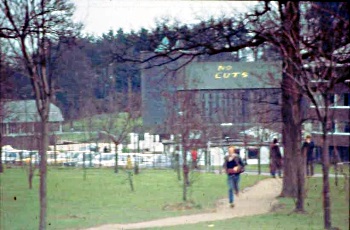 As the site is liable to subsidence due to old mine workings, the Chapel structure incorporates a number of safeguards, notably wide vertical and horizontal movement joints. These occur at intervals and serve to divide the building into small units which may move more or less independently of each other. Repairs and improvements were made to the access and parterre outside the Chapel in September 2012 to match the redeveloped Union Square.
As the site is liable to subsidence due to old mine workings, the Chapel structure incorporates a number of safeguards, notably wide vertical and horizontal movement joints. These occur at intervals and serve to divide the building into small units which may move more or less independently of each other. Repairs and improvements were made to the access and parterre outside the Chapel in September 2012 to match the redeveloped Union Square.
Photo left: "No Cuts" appears miraculously on the Chapel roof... 1980 by Chris Parkins (1981)
George Pace: Architect 1915-75
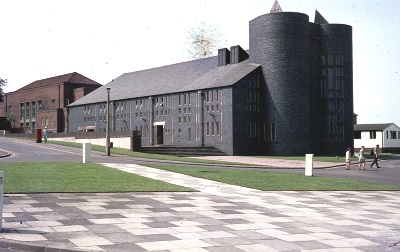 George Pace was born in Croydon Surrey. As a student, he won many prizes including the Pugin Studentship in 1937 and the RIBA Asphitel Prize for the best architectural student in England. He was influenced by Charles Rennie Macintosh and the work of William Morris, Lethaby and Burges. He declared a respect for modern architects like Walter Gropius whilst pursuing a passion for medieval Gothic. Early on, Pace formed close links with the Dean of York Minster and became architect to several cathedrals. He believed strongly in skill and craftsmanship and much of his professional practice involved the maintenance and restoration of historic churches. Major projects included Llandaff Cathedral and St Martin, Coney Street in York. Pace’s later designs for new buildings were rooted in this unique mix of the modern and the conservative and his belief that industrial architecture was an underestimated art form.
George Pace was born in Croydon Surrey. As a student, he won many prizes including the Pugin Studentship in 1937 and the RIBA Asphitel Prize for the best architectural student in England. He was influenced by Charles Rennie Macintosh and the work of William Morris, Lethaby and Burges. He declared a respect for modern architects like Walter Gropius whilst pursuing a passion for medieval Gothic. Early on, Pace formed close links with the Dean of York Minster and became architect to several cathedrals. He believed strongly in skill and craftsmanship and much of his professional practice involved the maintenance and restoration of historic churches. Major projects included Llandaff Cathedral and St Martin, Coney Street in York. Pace’s later designs for new buildings were rooted in this unique mix of the modern and the conservative and his belief that industrial architecture was an underestimated art form.
See: Peter Pace (1990) The Architecture of George Pace. London, Batsford.
Photo left: Chapel with the original chequered concourse, by Malcolm Payne (1969)
George Pratt and the Chapel Organ
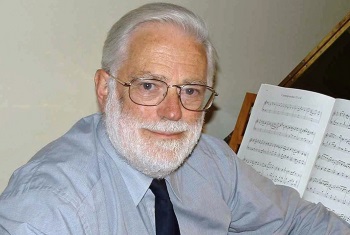 The Chapel Organ was designed and installed by George Pratt (1935-2017). George served as Director of Music at Keele from January 1964 until 1985. Another of his accomplishments was the appointment of the celebrated Lindsay String Quartet to a Leverhulme Scholarship as artists in residence at Keele. George is a very significant figure in Keele's history and he is frequently mentioned with affection and appreciation by alumni. He was a founder member of the Keele School of Music. His wife Mary Pratt (Class of 1983) was a Biology lecturer.
The Chapel Organ was designed and installed by George Pratt (1935-2017). George served as Director of Music at Keele from January 1964 until 1985. Another of his accomplishments was the appointment of the celebrated Lindsay String Quartet to a Leverhulme Scholarship as artists in residence at Keele. George is a very significant figure in Keele's history and he is frequently mentioned with affection and appreciation by alumni. He was a founder member of the Keele School of Music. His wife Mary Pratt (Class of 1983) was a Biology lecturer.
George was a member of the Master Singers: a prominent British vocal group in the 1960s. Comprising four schoolmasters, they specialised in comedic recordings of mundane documents and announcements such as the radio weather forecast and The Highway Code, performed a cappella as Anglican chant. Two of their records, "Highway Code" and "Weather Forecast", both produced by the Beatles' producer George Martin, reached the UK singles chart in 1966.
After Keele, he became a Professor of Music at the University of Huddersfield and was active in music education in schools and Universities throughout his life. As well as being a regular music reviewer for the BBC, he was a member of the Arts Council Music Panel, Vice-Chairman of the Music Board of the CNAA and Chairman of West Midlands Arts from 1976 to 1980. He was a member of the National Curriculum Music Working Group and led several major research projects concerned with making the statutory requirements of the National Curriculum workable in practice. He served on several advisory committees of the Higher Education Funding Council. He is a Past-President of the Incorporated Society of Musicians. At Huddersfield, he conducted the University Orchestra and Chamber Orchestra, directed Keele Baroque and the Harmonie Ensemble, and ran the Keele International Chamber Music Summer School. In April 1985 he directed the revival of Handel's opera Berenice, in the European Music Year.
Perhaps his most cherished scheme was raising £40k, through the establishment of a concert series, to rescue and restore the beautiful chamber organ at Powderham Castle, the estate of the Earl of Devon. ‘Music in the Castle’ not only brought this wonderful instrument to life again but established a venue for music in the region, most notably for New Generation Artists; performers from music schools and conservatoires. George leaves two sons and five grandchildren – two of whom played at his funeral, bearing testament to the vision and enthusiasm for music-making that was the focus of his life.

